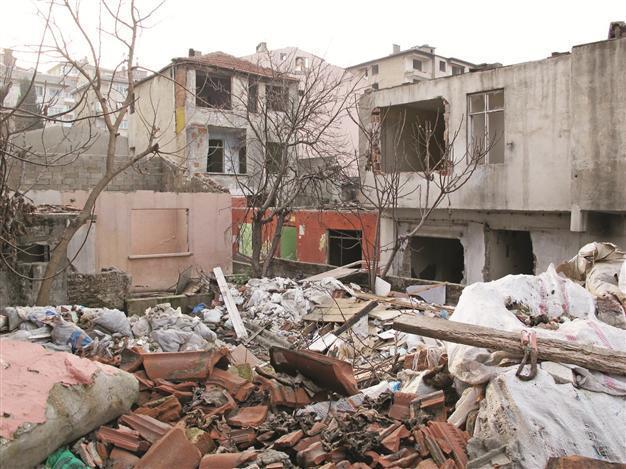Istanbul Fikirtepe weekend safari with Murat Germen
Wilco Van Herpen

Istanbul’s Fikirtepe has been demolished by the municipality for a prestigious project. The old houses in the area will be replaced with the new ones.
This weekend, I went with my friend Murat Germen on a photo safari in Istanbul. We have been planning to take pictures together for a long time and at the same time using this safari for a bit of gossip about our friends and info exchange about the projects we are working on. Murat is one of the few contemporary photography artists in Turkey who manages to earn some money with the art that is being sold by galleries in Turkey, America and the Netherlands.Last year, he published a book with pictures of projects he has worked on since 2000. The initial publication of his book would have been before May 2000, but due to an unforeseen delay it was published in October 2000. Murat is very happy that this happened because this gave him the change to add pictures he took during the Gezi Park protests that started May 31, 2013. His idea behind it – if you publish a photography book about New Turkey and do not add these events, then he does not consider that New Turkey at all.
He brought me to Fikirtepe, an area of Istanbul near Kadıköy. A part of Fikirtepe used to be a poor neighborhood with houses that used to be gecekondu (houses build in one night). A lot of houses built on top of each other, and in between them, very narrow alleys. It was a very lively area where everybody knew each other, but the municipality decided this area would be demolished and a prestigious project would replace these houses.
Shining aluminum fence
When we arrived, the first thing that caught my eye was an immense shining aluminum fence that encircled the quarter. Behind the fence were houses ready to be demolished. I started to take some pictures and soon discovered a nice pattern in one of the buildings. It was almost as if the famous Dutch painter Mondriaan had worked here; cubistic shapes and various colors give it a surrealistic abstract touch. I climbed on a truck that was parked across the street. Murat, in the meanwhile, was checking out the fence if there was any possibility to enter this ghost area and it did not take long before he called me to come. Someone had bent one of the sides of the aluminum plate and created a perfect entrance to the area.
The first image that I saw was that of a row of houses side by side with all the windows removed. Glass and tiles were spread out all over the place; piles of dirt covered the floor. The walls of the houses were covered with slogans, all of them in Arabic. It was as if I had entered a warzone, the images I saw here were lookalike images of pictures I had seen in the newspapers here in Turkey. The news in those newspapers was about Syria. It turned out that a couple of television channels in Turkey that make television series had used this area as décor for scenes about Syria.
All the houses were stripped; no doors, no windows, no electricity cables. Even all the toilets were gone. In the middle of a couple of houses two or three trees remained as quiet and silent witnesses of the better times they had once known. The whole area made me sad, such a contrast with the euphoric feeling I had while I made my “Mondriaan” pictures.
When I turned around the corner I saw a woman sorting out waste that was spread around the area. Huge bags with litter were waiting to be sorted as well. The woman was the only one, together with her family, who was still living in this area. Her house was nothing more than a little club without water, gas or a toilet. The electricity they tapped from a lamppost 50 meters away from their shack.
Garbage collectors
Everybody in the area had left their house after they got compensation for their houses. The problem for this family was the place they used to stay in was a rental house; the owner got his money but those poor people did not get any compensation. With no money and no place to go to the woman and her family had decided that they would stay until workers demolish their “house.”
They were garbage collectors; the people you can see on the streets with the handcars covered with a big bag. They collect plastic, paper, metal and all other different kinds of things people throw away. After sorting out all the garbage they get a price per kilo.
Many times, the woman told us, it happens that people of the municipality arrest the people, confiscate their handcars, release them and then offer them to buy their handcar back. Her children attend school and after school help their mother collect garbage. Their life is hard and difficult; nobody seems to care about those people.
















